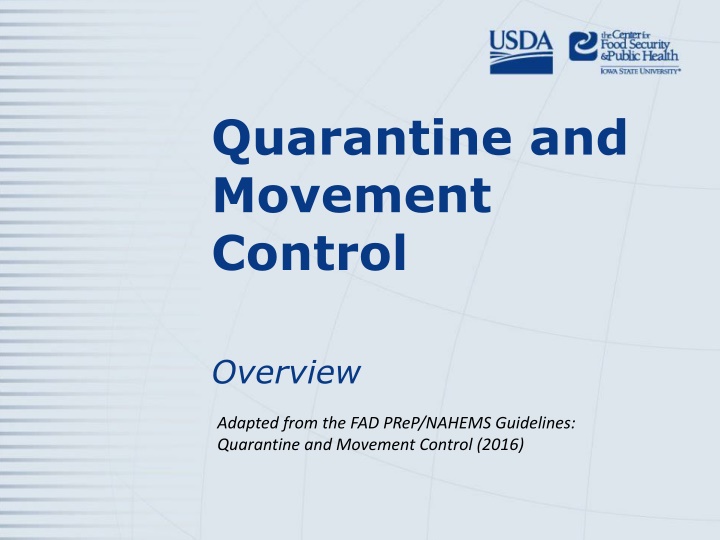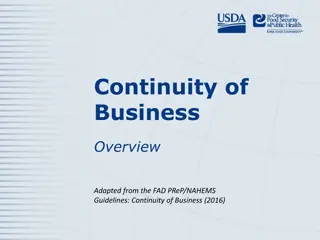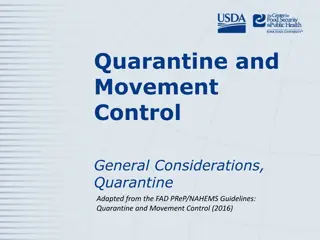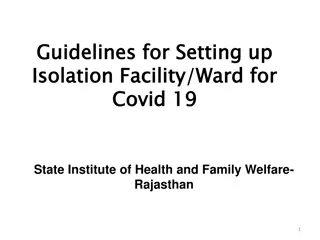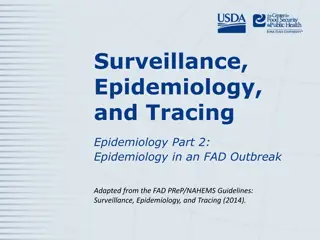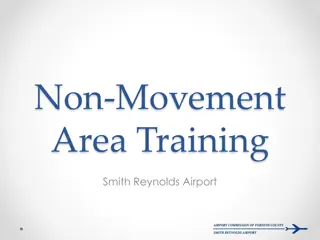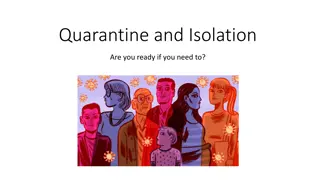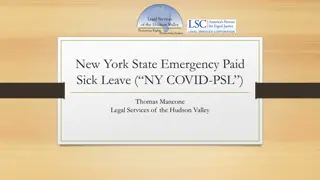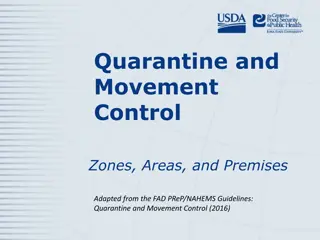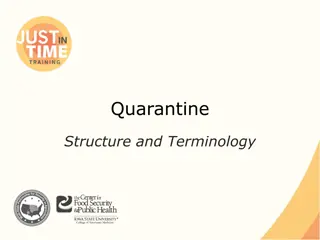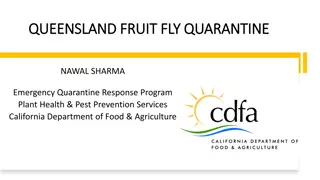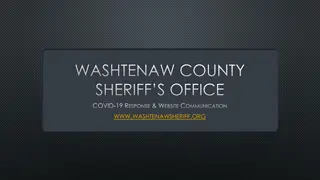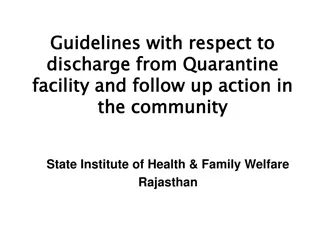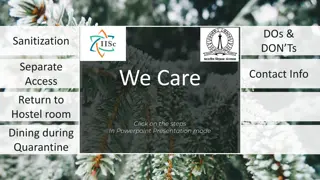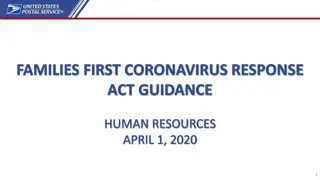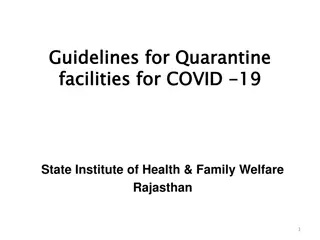Quarantine and Movement Control Overview: FAD Response Guidelines
This presentation delves into the definitions, authority, and considerations related to quarantine and movement control, emphasizing the FAD response goals of detecting, controlling, and eradicating diseases in animals while aiming for continuity of business and minimizing disruptions.
Download Presentation

Please find below an Image/Link to download the presentation.
The content on the website is provided AS IS for your information and personal use only. It may not be sold, licensed, or shared on other websites without obtaining consent from the author.If you encounter any issues during the download, it is possible that the publisher has removed the file from their server.
You are allowed to download the files provided on this website for personal or commercial use, subject to the condition that they are used lawfully. All files are the property of their respective owners.
The content on the website is provided AS IS for your information and personal use only. It may not be sold, licensed, or shared on other websites without obtaining consent from the author.
E N D
Presentation Transcript
Quarantine and Movement Control Overview Adapted from the FAD PReP/NAHEMS Guidelines: Quarantine and Movement Control (2016)
This Presentation Definition of relevant terms Authority of responsible agencies FAD response activities General quarantine and movement control (QMC) considerations Concepts of permitting Personnel responsibilities FAD-PReP/NAHEMS Guidelines: Quarantine & Movement Control - Overview 2 USDA APHIS and CFSPH
Definitions Quarantine Stringent restrictions Prohibits movement from specified premises, area, or region Hold order Temporary, during investigation Usually under State authority Standstill notice Temporary, prohibits new movement Federal authority/official notice FAD-PReP/NAHEMS Guidelines: Quarantine & Movement Control - Overview 3 USDA APHIS and CFSPH
Definitions contd Movement control Controls movement in Control Area Movement from premises with no evidence of infection Permits based on meeting criteria Continuity of business (COB) Managed movement for specific commodity FAD-PReP/NAHEMS Guidelines: Quarantine & Movement Control - Overview 4 USDA APHIS and CFSPH
FAD Response Goals 1. Detect, control, and contain the disease in animals as quickly as possible; 2. Eradicate the disease using strategies that seek to stabilize animal agriculture, the food supply, and the economy and that protect public health and the environment; and 3. Provide science- and risk-based approaches and systems to facilitate continuity of business for non-infected animals and non- contaminated animal products. FAD-PReP/NAHEMS Guidelines: Quarantine & Movement Control - Overview 5 USDA APHIS and CFSPH
FAD Response Goals contd Achieving these three goals will allow individual livestock facilities, States, Tribes, regions, and industries to resume normal production as quickly as possible. They will also allow the United States to regain disease-free status without the response effort causing more disruption and damage than the disease outbreak itself. FAD-PReP/NAHEMS Guidelines: Quarantine & Movement Control - Overview 6 USDA APHIS and CFSPH
Goals of QMC Preparedness goals Develop effective QMC plans for affected locations Develop effective managed movement plans for non-infected locations Response goals Establish a Control Area within 6 hours Implement QMC in the Control Area quickly Consider competing priorities - disease transmission vs. critical movements FAD-PReP/NAHEMS Guidelines: Quarantine & Movement Control - Overview 7 USDA APHIS and CFSPH
Authorities FAD-PReP/NAHEMS Guidelines: Quarantine & Movement Control - Overview 8 USDA APHIS and CFSPH
Federal Authority APHIS authority through AHPA Act Secretary of Agriculture is authorized to: Prevent, detect, control, and eradicate diseases and pests of animals Protect animal health, human health and welfare, and economic interests Prohibit importation, entry or interstate movement throughout US Prevent the introduction or dissemination of disease FAD-PReP/NAHEMS Guidelines: Quarantine & Movement Control - Overview 9 USDA APHIS and CFSPH
State Authority Initially, State, Tribal, local authorities and resources Authority granted to SAHO varies Quarantine May be issued on FAD detection or suspicion Scope based on specific authority Intended to control disease intrastate FAD-PReP/NAHEMS Guidelines: Quarantine & Movement Control - Overview 10 USDA APHIS and CFSPH
Extraordinary Emergency Declared by US Secretary of Agriculture Federal government authorized to control intrastate movement In addition to interstate and international movement Regulatory intervention By Unified Incident Command: State, Tribal Nations, and Federal FAD-PReP/NAHEMS Guidelines: Quarantine & Movement Control - Overview 11 USDA APHIS and CFSPH
Response to a Foreign Animal Disease Outbreak FAD-PReP/NAHEMS Guidelines: Quarantine & Movement Control - Overview 12 USDA APHIS and CFSPH
Critical Activities Critical Activities and Tools for Containment, Control, and Eradication Public awareness campaign Swift imposition of effective QMC Rapid diagnosis and reporting Epidemiological investigation and tracing Increased surveillance COB measures for non-infected animals and non-contaminated animal products Biosecurity measures Cleaning and disinfection measures Effective and appropriate disposal procedures Mass depopulation and euthanasia (as response strategy indicates) Emergency vaccination (as the response strategy indicates) FAD-PReP/NAHEMS Guidelines: Quarantine & Movement Control - Overview 13 USDA APHIS and CFSPH
Zones, Areas, Premises FAD-PReP/NAHEMS Guidelines: Quarantine & Movement Control - Overview 14 USDA APHIS and CFSPH
General Considerations for Quarantine and Movement Control FAD-PReP/NAHEMS Guidelines: Quarantine & Movement Control - Overview 15 USDA APHIS and CFSPH
Coordination and Planning Coordination conducted through ICS Planning enhances efficiency Determine authorities Identify resources Identify agricultural routes Develop communications plans Ensure appropriate supplies Understand roles and responsibilities FAD-PReP/NAHEMS Guidelines: Quarantine & Movement Control - Overview 16 USDA APHIS and CFSPH
Progression of Activities FAD-PReP/NAHEMS Guidelines: Quarantine & Movement Control - Overview 17 USDA APHIS and CFSPH
Individual Premises Quarantine (Typically State) FAD-PReP/NAHEMS Guidelines: Quarantine & Movement Control - Overview 18 USDA APHIS and CFSPH
Implementing Premises Quarantine State authority varies by State Criteria for issuance varies by State Animals may or may not be present Notify owner/agent and secure premises Establish biosecurity and restrict movement Develop contingency plans Prepare for essential movement and medical emergencies FAD-PReP/NAHEMS Guidelines: Quarantine & Movement Control - Overview 19 USDA APHIS and CFSPH
Area or Region Quarantine (Control Area) FAD-PReP/NAHEMS Guidelines: Quarantine & Movement Control - Overview 20 USDA APHIS and CFSPH
Implementing Federal Area Quarantine Federal authority to quarantine a Control Area Disease agent, trading considerations, State-specific issues, epidemiology Appear as Federal Register Notice Can be effected prior to publication In addition to premises quarantines Unified Command, State and Federal States efforts reimbursed FAD-PReP/NAHEMS Guidelines: Quarantine & Movement Control - Overview 21 USDA APHIS and CFSPH
Quarantine Release Premises quarantine released if confident with disease status Federal area quarantine release indicated by Federal Register notice Does not need to be all at once, reducing the size of the Control Area gradually Trade considerations or epidemiologic information FAD-PReP/NAHEMS Guidelines: Quarantine & Movement Control - Overview 22 USDA APHIS and CFSPH
Recent FAD Control Areas HPAI Control Areas were established Around Infected and Contact Premises Federal area quarantines were not established May/may not be established during an FAD outbreak FAD-PReP/NAHEMS Guidelines: Quarantine & Movement Control - Overview 23 USDA APHIS and CFSPH
Movement Control and Permitting FAD-PReP/NAHEMS Guidelines: Quarantine & Movement Control - Overview 24 USDA APHIS and CFSPH
Control Area Movements Moving animals, animal products, fomites Broad guidance APHIS Foreign Animal Disease Framework: Response Strategies (FAD PReP Manual 2-0) Specific criteria Science Risk of disease transmission Circumstances of the outbreak FAD-PReP/NAHEMS Guidelines: Quarantine & Movement Control - Overview 25 USDA APHIS and CFSPH
Continuity of Business COB, managed movement Specific criteria for movement Voluntary participation Specific criteria Surveillance Cleaning, disinfection Biosecurity measures Epidemiological information FAD-PReP/NAHEMS Guidelines: Quarantine & Movement Control - Overview 26 USDA APHIS and CFSPH
Permitting Specific or COB movements Considers risk assessments, surveillance, biosecurity, national and OIE standards Significant information management EMRS2 is the system of record for an animal health emergency response FAD-PReP/NAHEMS Guidelines: Quarantine & Movement Control - Overview 27 USDA APHIS and CFSPH
Checkpoints Enforce requirements May need accompanying permit Verifies vehicle is in compliance with all movement criteria Avoid threatening animal welfare Standard operating procedures provided through Incident Command Violations reported to officials FAD-PReP/NAHEMS Guidelines: Quarantine & Movement Control - Overview 28 USDA APHIS and CFSPH
Personnel FAD-PReP/NAHEMS Guidelines: Quarantine & Movement Control - Overview 29 USDA APHIS and CFSPH
Responsibility and Coordination National Incident Coordination Group Gathers resources, evaluates policy options, implements strategies Incident Management Team Handles operations in the field Communicates with owners, coordinates with other ICS personnel Permits allowable movements FAD-PReP/NAHEMS Guidelines: Quarantine & Movement Control - Overview 30 USDA APHIS and CFSPH
Hazards Responder safety Orientation covering precautions Required personal protective equipment Biosecurity Prevent disease spread Knowingly or unknowingly contaminated Understand pathogen transmission Work zones control access FAD-PReP/NAHEMS Guidelines: Quarantine & Movement Control - Overview 31 USDA APHIS and CFSPH
For More Information FAD PReP/NAHEMS Guidelines: Quarantine and Movement Control http://www.aphis.usda.gov/fadprep Quarantine and Movement Control web-based training module http://naherc.cfsph.iastate.edu/ FAD-PReP/NAHEMS Guidelines: Quarantine & Movement Control - Overview 32 USDA APHIS and CFSPH
Guidelines Content Authors (CFSPH) Janice P. Mogan, DVM Heather Allen, PhD, MPA Kristen Bretz, MS Reviewers (USDA) Randall Crom, DVM (Retired) Jonathan Zack, DVM FAD-PReP/NAHEMS Guidelines: Quarantine & Movement Control - Overview 33 USDA APHIS and CFSPH
Acknowledgments Development of this presentation was by the Center for Food Security and Public Health at Iowa State University through funding from the USDA APHIS Veterinary Services PPT Authors: Janice Mogan, DVM; Logan Kilburn Reviewers: Kristen Bretz, MS
